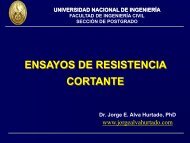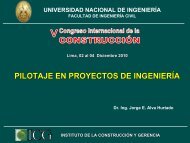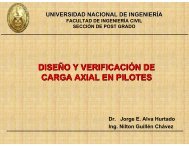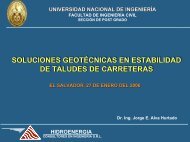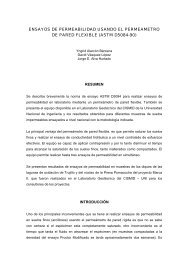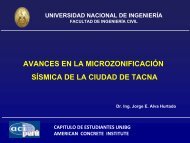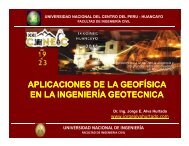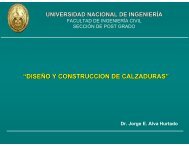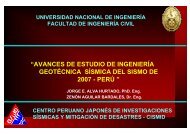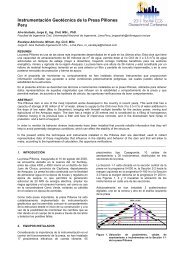Diseño y Construccón de Túneles - Dr. Ing. Jorge Elias Alva Hurtado
Diseño y Construccón de Túneles - Dr. Ing. Jorge Elias Alva Hurtado
Diseño y Construccón de Túneles - Dr. Ing. Jorge Elias Alva Hurtado
You also want an ePaper? Increase the reach of your titles
YUMPU automatically turns print PDFs into web optimized ePapers that Google loves.
UNIVERSIDAD NACIONAL DE INGENIERIAFACULTAD DE INGENIERIA CIVILDel 8 al 12<strong>de</strong> Agosto <strong>de</strong>l 2011“Edificando las bases <strong>de</strong>l <strong>de</strong>sarrollo”DISEÑO O Y CONSTRUCCIÓN N DETÚNELES<strong>Dr</strong>. <strong>Jorge</strong> E. <strong>Alva</strong> <strong>Hurtado</strong>www.jorgealvahurtado.com
Condiciones <strong>de</strong>l Macizo Rocoso en un TúnelTMISMO TIPO DE ROCA, VARIACION DE CONDICIONESPOCOMUYSRALTSANOFRACTSANO ALT SRMALO MEDIO BUENO MEDIOBUENO MED MALODIFERENTES CONDICIONES, MISMO TIPO DE COMPORTAMIENTO
Condiciones <strong>de</strong>l Macizo Rocoso en un TúnelTMALO MEDIO BUENOMALOMEDIOMALODIFERENTES TIPOS DE ROCA, COMPORTAMIENTO SIMILAR
CLASIFICACIÓN N GEOMECÁNICASe busca clasificar tipos <strong>de</strong> comportamiento <strong>de</strong>l macizo rocoso.El mismo tipo <strong>de</strong> roca pue<strong>de</strong> cambiar <strong>de</strong> condiciones a lo largo <strong>de</strong>lalineamiento, exigiendo diferentes tipos <strong>de</strong> soporte <strong>de</strong> laexcavación.Diferentes tipos <strong>de</strong> roca pue<strong>de</strong>n presentar la misma necesidad <strong>de</strong>soporte.Los distintos tipos <strong>de</strong> condiciones <strong>de</strong>l macizo rocoso en cuanto asu comportamiento en la excavación y la necesidad <strong>de</strong> soporteconllevan a adoptar diferentes CLASES DE MACIZO ROCOSO(CLASE DE ROCA)
Existen Varios Tipos <strong>de</strong> ClasificacionesLas más Importantes:‣ Terzaghi (1946)‣ Deere (1968)‣ Bieniawski (1976)‣ Barton (1974)
CLASIFICACIÓN N DE TERZAGHIB+HK (B+H)K (B+H)HHBB
CLASIFICACIÓN N DE TERZAGHICarga <strong>de</strong> Roca en el Techo <strong>de</strong>l TúnelTA una Profundidad Mayor que 1,5 (B+ H)Mo<strong>de</strong>rately blocky and seamyMedianamente fracturada y con vetas débiles0,25B a 0,35 (B+H)Very blocky and seamyMuy fracturada y con vetas débiles0,35 a 1,1 (B+H)Completely crushed but chemically intactTotalmente fragmentada pero sana1,1 (B+H)Squeezing rock, mo<strong>de</strong>rate <strong>de</strong>pthRoca plastica, profundidad mediana1,1 a 2,1 (B+H)Squeezing rock, great <strong>de</strong>pthRoca plástica, gran profundidad2,1 a 4,5 (B+H)Swelling rockRoca expansivaHasta 250 pies (80 m)
CLASIFICACIÓN N DE DEEREBASADO EN EL RQDEJEMPLO APROXIMADO:RQD (%) PERNOS SHOTCRETE90 – 100 no (esporádico) no; local (3- 5cm)75 – 90 cada 2 m 3-5 cm en el techo50 – 75 cad a 1,7 m 10 cm techo y pare<strong>de</strong>s25 – 50 cada 1,5 m 15 cm con fibra / malla< 25 ---- 25 cm (shotcrete / mol<strong>de</strong>ado)
CLASIFICACIÓN N DE BIENIAWSKIAtribuye grados parciales a cada factor:‣ Resistencia <strong>de</strong> la roca intacta‣ RQD‣ Espaciamiento <strong>de</strong> las discontinuida<strong>de</strong>s‣ Condición <strong>de</strong> las discontinuida<strong>de</strong>s‣ Agua subterránea‣ Orientación <strong>de</strong> las discontinuida<strong>de</strong>sLa suma <strong>de</strong> los grados parciales resulta en un grado general, queclasifica la calidad <strong>de</strong> macizo (RMR-Rock Mass Rating):81 – 100:61 – 80:41 – 60:21 – 40:< 20:Muy buenoBuenoSatisfactorioMaloMuy malo
Sistema RMRRock Mass Rating (Bieniawski)Fuente: Rock EngineeringE. Hoek, Cap. 3, Ed.Se encuentra para <strong>de</strong>scarga enla pagina <strong>de</strong> Rocscience.com
Sistema RMR Rock Mass Rating (Bieniawski)Fuente: Rock Engineering E. Hoek, Cap. 3, Ed.
CLASIFICACIÓN N DE BARTONSe basa en los siguientes parámetros:• RQD• Jn – Joint set number (grado <strong>de</strong> fracturamiento <strong>de</strong>l macizo)• Jr – Joint roughness number (<strong>de</strong>pen<strong>de</strong> <strong>de</strong> rugosidad <strong>de</strong> fractura)• Ja – Joint alteration number (<strong>de</strong>pen<strong>de</strong> <strong>de</strong> superficie <strong>de</strong> fractura)• Jw – Joint water reduction (<strong>de</strong>pen<strong>de</strong> <strong>de</strong> presiones hidrostáticas)• SRF – Stress reduction factor (<strong>de</strong>pen<strong>de</strong> <strong>de</strong> esfuerzos <strong>de</strong>l macizo)INDICE DE CALIDAD DEL MACIZO (Q):Q = (RQD/Jn). (Jr/Ja). (Jw/SRF)
Clasificación n <strong>de</strong> BartonValores <strong>de</strong> los Parámetros característicos <strong>de</strong>l Índice QReferencia: <strong>Ing</strong>eniería Geológica. Luis Gonzáles <strong>de</strong> Vallejo. 2004.Madrid-España.
Valores <strong>de</strong> los Parámetros característicos <strong>de</strong>l Índice QReferencia: <strong>Ing</strong>eniería Geológica. Luis Gonzáles <strong>de</strong> Vallejo. 2004.Madrid-España.
Valores <strong>de</strong> los Parámetros característicos <strong>de</strong>l Índice QReferencia: <strong>Ing</strong>eniería Geológica. Luis Gonzáles <strong>de</strong> Vallejo. 2004.Madrid-España.
Clasificación n <strong>de</strong> Barton
TÚNELES PROYECTO CHEVES
Volumen Shotcrete (m 3 ) 199.99 147.35 242.55 134.12 404.25 134.12 363.825 199.99TÚNEL DE CONDUCCIÓN –PROYECTO CHEVESProgresivas 0+000 ‐ 0+100 0+100 ‐ 0+200 0+200 ‐ 0+500 0+500 ‐ 0+600 0+600 ‐ 1+100 1+100 ‐ 1+200 1+200 ‐ 1+650 1+650 ‐ 1+750Tramos (m) 100 100 300 100 500 100 450 100R.Q.D. 20 20 40 20 40 20 40 20Jn 12 6 6 6 6 6 6 12Jr 1 1 1 1 1 1 1 1Ja 8 6 4 4 4 4 4 8Jw 1 1 1 1 1 1 1 1S.R.F. 10 5 2 5 2 5 2 10Indice Q 0.02 0.11 0.83 0.17 0.83 0.17 0.83 0.02D e4.2 4.2 4.2 4.2 4.2 4.2 4.2 4.2Zona 7 6 5 6 5 6 5 7Tipo Roca EXT. MALA MUY MALA MUY MALA MUY MALA MUY MALA MUY MALA MUY MALA EXT. MALAPerno Longitud (m) 2.5 2.5 2.5 2.5 2.5 2.5 2.5 2.5Espaciado (m) 1.1 1.3 1.6 1.3 1.6 1.3 1.6 1.1Esp. Shotcrete (cm) 15 11 6 10 6 10 6 15Fibra SI SI SI SI SI SI SI SICerchas ‐ ‐ ‐ ‐ ‐ ‐ ‐ ‐Nº Pernos/Sección 12 10 8 10 8 10 8 12Nº Pernos 1092 770 1504 770 2504 770 2248 1092Area Shotcrete (m 2 ) 1.9999 1.4735 0.8085 1.3412 0.8085 1.3412 0.8085 1.9999
Volumen Shotcrete (m 3 ) 363.825 268.24 ‐ 876.85 ‐ 376.39 216.08 340.326TÚNEL DE CONDUCCIÓN –PROYECTO CHEVESProgresivas 1+750 ‐ 2+200 2+200 ‐ 2+400 2+400 ‐ 2+500 2+500 ‐ 3+800 3+800 ‐ 4+250 4+250 ‐ 4+600 4+600 ‐ 5+000 5+000 ‐ 5+630Tramos (m) 450 200 100 1300 450 350 400 630R.Q.D. 40 30 80 60 80 40 80 80Jn 6 9 9 9 9 9 6 6Jr 1 1 2 2 2 1 3 3Ja 4 8 1 3 1 2 1 1Jw 1 1 1 1 1 1 1 1S.R.F. 2.5 2 2 5 2 5 10 20Indice Q 0.67 0.21 8.89 0.89 8.89 0.44 4.00 2.00D e4.2 4.2 4.2 4.2 4.2 4.2 4.2 4.2Zona 5 6 1 5 1 5 4 4Tipo Roca MUY MALA MUY MALA MEDIA MUY MALA MEDIA MUY MALA MALA MALAPerno Longitud (m) 2.5 2.5 ‐ 2.5 ‐ 2.5 2.5 2.5Espaciado (m) 1.6 1.4 ‐ 1.7 ‐ 1.5 2.1 1.8Esp. Shotcrete (cm) 6 10 ‐ 5 ‐ 8 4 4Fibra SI SI ‐ SI ‐ SI ‐ ‐Cerchas ‐ ‐ ‐ ‐ ‐ ‐ ‐Nº Pernos/Sección 8 9 ‐ 7 ‐ 8 6 7Nº Pernos 2248 1287 ‐ 5355 ‐ 1864 1140 2450Area Shotcrete (m 2 ) 0.8085 1.3412 ‐ 0.6745 ‐ 1.0754 0.5402 0.5402
Volumen Shotcrete (m 3 ) 345.728 147.35 232.286 147.35 162.06 147.35 561.808 120.84TÚNEL DE CONDUCCIÓN –PROYECTO CHEVESProgresivas 5+630 ‐ 6+270 6+270 ‐ 6+370 6+370 ‐ 6+800 6+800 ‐ 6+900 6+900 ‐ 7+200 7+200 ‐ 7+300 7+300 ‐ 8+340 8+340 ‐ 8+440Tramos (m) 640 100 430 100 300 100 1040 100R.Q.D. 80 40 80 40 80 40 80 30Jn 6 9 6 9 6 9 6 12Jr 3 2 3 2 3 2 3 2Ja 1 4 1 4 1 4 1 4Jw 1 1 1 1 1 1 1 1S.R.F. 10 20 10 20 10 20 10 5Indice Q 4.00 0.11 4.00 0.11 4.00 0.11 4.00 0.25D e4.2 4.2 4.2 4.2 4.2 4.2 4.2 4.2Zona 4 6 4 6 4 6 4 6Tipo Roca MALA MUY MALA MALA MUY MALA MALA MUY MALA MALA MUY MALAPerno Longitud (m) 2.5 2.5 2.5 2.5 2.5 2.5 2.5 2.5Espaciado (m) 2.1 1.3 2.1 1.3 2.1 1.3 2.1 1.4Esp. Shotcrete (cm) 4 11 4 11 4 11 4 9Fibra ‐ SI ‐ SI ‐ SI ‐ SICerchas ‐ ‐ ‐ ‐ ‐ ‐ ‐ ‐Nº Pernos/Sección 6 10 6 10 6 10 6 9Nº Pernos 1830 770 1230 770 858 770 2970 639Area Shotcrete (m 2 ) 0.5402 1.4735 0.5402 1.4735 0.5402 1.4735 0.5402 1.2084
Total Solo Shotcrete (m 3 ) 2171.60TÚNEL DE CONDUCCIÓN –PROYECTO CHEVESProgresivas 8+440 ‐ 8+560 8+560 ‐ 8+660 8+660 ‐ 9+120 9+120 ‐ 9+220 9+220 ‐ 9+690Tramos (m) 120 100 460 100 40R.Q.D. 60 30 60 30 40Jn 9 12 9 12 9Jr 2 2 2 2 2Ja 3 4 2 4 2Jw 1 1 1 1 1S.R.F. 2.5 5 2.5 5 5Indice Q 1.78 0.25 2.67 0.25 0.89D e4.2 4.2 4.2 4.2 4.2Zona 4 6 4 6 5Tipo Roca MALA MUY MALA MALA MUY MALA MUY MALAPerno Longitud (m) 2.5 2.5 2.5 2.5 2.5Espaciado (m) 1.8 1.4 1.9 1.4 1.7Esp. Shotcrete (cm) 4 9 4 9 5Fibra ‐ SI ‐ SI SICerchas ‐ ‐ ‐ ‐ ‐Nº Pernos/Sección 7 9 7 9 7Nº Pernos 469 639 1694 639 168Total Pernos 38540Area Shotcrete (m 2 ) 0.5402 1.2084 0.5402 1.2084 0.6745Volumen Shotcrete (m 3 ) 64.824 120.84 248.492 120.84 26.98Total Shotcrete + Fibra(m 3 ) 4543.05
TÚNEL EJEMPLO DE OBRA
EJECUCIÓNPERFORACIONCARGA Y DETONACIONVENTILACIONLIMPIEZA
“JUMBO” DE PEFORACIÓNCON DOS BRAZOS
PERFORACIÓN CONMARTILLO DE AIRECOMPRIMIDOEQUIPO SOBREORUGA Y COMANDOSHIDRAÚLICOS“JUMBO”
PERFORACIONES PARA VOLADURACONO CENTRAL, TALADROS DE CONTORNO Y NORMALES
CARGA DE EXPLOSIVOS
SCOOPTRAIN DESCARGANDO MATERIAL EXCAVADO
BOCA DE TUNEL, VENTILADOR Y MANGA DE AIRE
FILTRACIÓN N DE AGUA YDRENAJE
DREN PROFUNDO VERTIENDO AGUA
CUNETA DE DRENAJE LATERAL
SOPORTE DE LA EXCAVACIÓNPERNOSCONCRETO PROYECTADOCERCHAS METALICASMARCHI AVANTI
CUÑA A EN EL TECHO FORMADA POR DOS FRACTURAS
PERFORACIÓN N E INSTALACIÓN N DE PERNO, CEMENTADOCON RESINA
PERNOS A INSTALARPERNO CON AGUACEMENTACIÓNDEFICIENTE
PERNOS INSTALADOS EN EL TECHO Y PAREDES
PERNO SIN FUNCIONAR: PLACA NO APOYADA EN LA ROCA
CONCRETO PROYECTADO (SHOTCRETE) CON FIBRA DE ACEROPERFORACIÓN DE DREN CON MARTILLO MANUAL
COSTILLAS DE REFUERZO EN SHOTCRETE
SHOTCRETE CON MALLA METALICA
PROBLEMAS(NO HAY TÚNEL TQUE NOPRESENTE ALGUNO!)
RUPTURA DE PILARCONSTRUCTOR NO EJECUTÓ LOSSOPORTES RECOMENDADOS
DESMORONAMIENTOSCONTACTO ENTREARENISCA Y PIZARRACAUSA: SOPORTEINCOMPLETO DELTRECHO ANTERIOR
PROCEDIMIENTOS DE EJECUCIÓN N ENTERRENO MUY DIFÍCILES:Avances cortos (1 a 2 m)Avanzar solamente <strong>de</strong>spués <strong>de</strong> la instalación <strong>de</strong>l soporteParcializar la excavaciónCorona a<strong>de</strong>lante y bancada retrasadaRefuerzo <strong>de</strong>l soporte:Cerchas metálicasMayor espesor <strong>de</strong>l concretoMarchi avanti
CERCHAS METÁLICAS POR INSTALAR
DETALLE CERCHA EN INSTALACIÓN
MARCHI AVANTI Y SHOTCRETE
EXTENSOMETRO SIMPLESTaladroPared <strong>de</strong>l TunelBarra <strong>de</strong> CobreCementacion(Roca)Distancia aControlarControla el Desplazamiento <strong>de</strong>la Pared con relacion al TramoCementado (Fijo)
TÚNEL SANTA ROSARIMAC – SAN JUAN DELURIGANCHO
ESTACION GEOMECANICA JAHITúnel Sur Km 1+012Ajuste <strong>de</strong> la Valuación por Orientación <strong>de</strong> las fisurasPARAMETROSTUNELMuyFavorable Favorable Regular Desfavorable Muy<strong>de</strong>sfavorableValuación 0 ‐2 ‐5 ‐10 ‐12VALOR TOTAL R.M.R (SUMA DE VALUACIONES) 51
Gráfico <strong>de</strong> concentración <strong>de</strong> polos y familias <strong>de</strong>discontinuida<strong>de</strong>s para toda la zona <strong>de</strong>l proyecto
Formación <strong>de</strong> cuñas inestables familias 2, 3 y 4
Formación n <strong>de</strong> cuñas inestables familias 1, 3 y 6
Túneles Gemelos
REFERENCIAS




